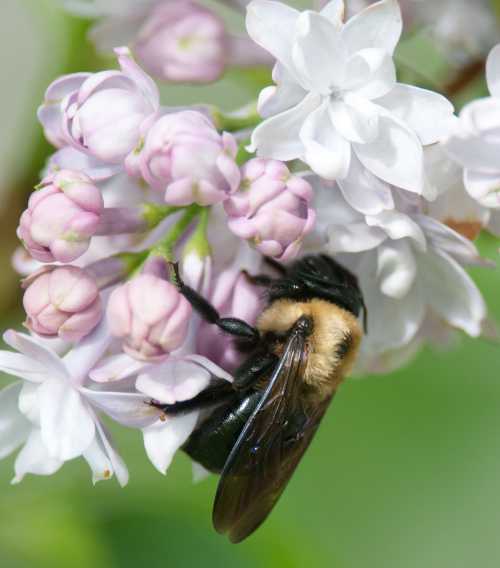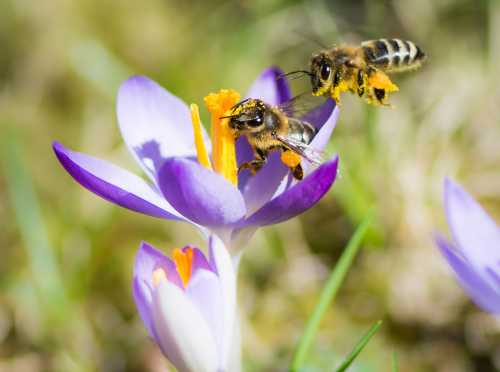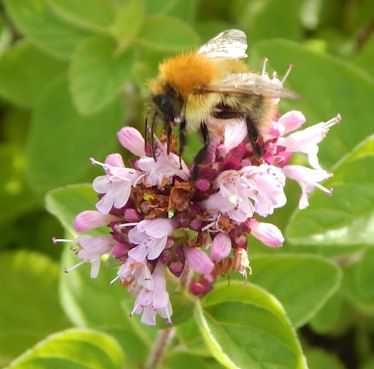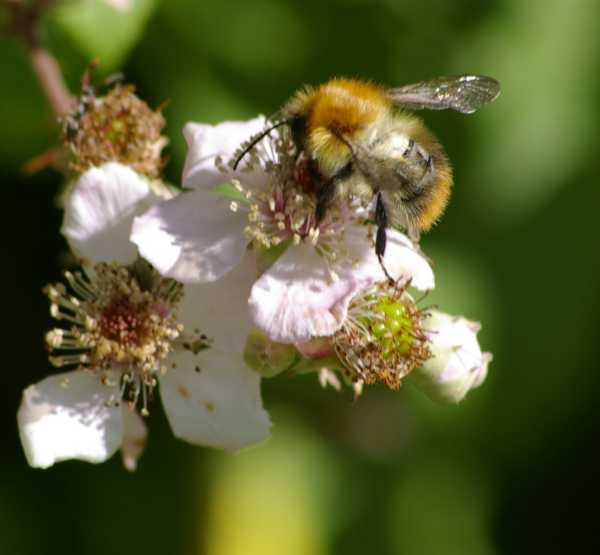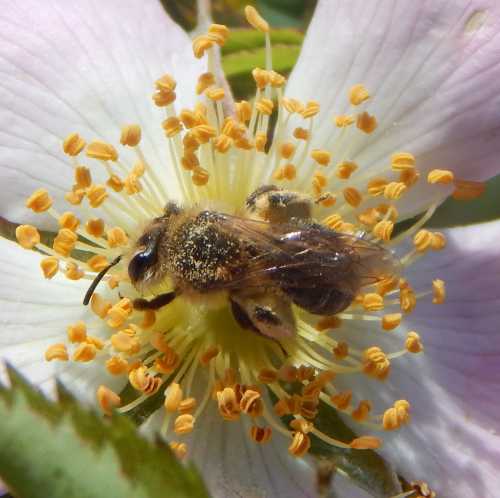Which Bees Have Long Or Short Tongues?
Do bees really have tongues? Which bees have long or short tongues? How long is the tongue of a bee? Are all bee tongues the same? What do bees use their tongues for?
All of these are common questions, so let's take a look at the tongue of the bee.
About Bee Tongues: What is a bee tongue?
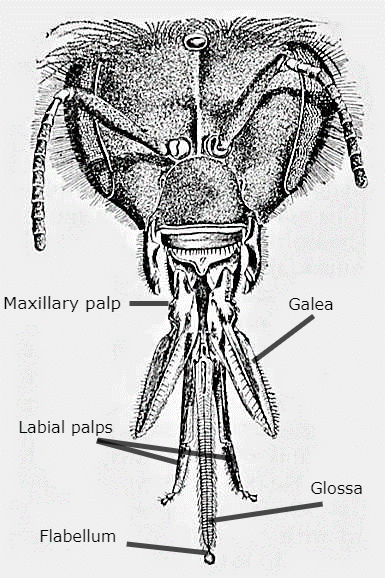 Mouthparts of a honey bee worker, adapted from J. Arthur Thomson, M.A., LL.D., Outlines of Zoology, Edinburgh [etc.] H. Frowde and Hodder & Stoughton, 1906.
Mouthparts of a honey bee worker, adapted from J. Arthur Thomson, M.A., LL.D., Outlines of Zoology, Edinburgh [etc.] H. Frowde and Hodder & Stoughton, 1906.Depending on the works and writings you are reading, the tongues of bees might be called the proboscis which in fact refers to a collection of jointed mouthparts.
However, other writings may prefer to reference only one part of the proboscis to describe the tongue, that being the glossa which is scientifically more accurate.
However, for the purposes of this page, I'm going to write about the collection of mouthparts (proboscis) as well as the glossa (tongue). Hopefully it will be clear to the reader why I have done this. You'll discover that assumptions which, to the non-scientist may seem perfectly plausible, are nevertheless actually a little more complicated than they first seemed.
How long is a bee tongue?
All bees are described generally as either long-tongued or short-tongued bees.
However, the length of the glossa is not what determines whether a bee is categorized as long or short- tongued.
Authors Wilson & Messinger Carril in The Bees In Your Backyard note:
“The tongue, or glossa, is not actually the feature most indicative of a long-tongued bee – it is instead four tiny segments that run next to the tongue called the labial palps.
In long-tongued bees the first two segments (those closest to the bee’s head) are much longer than the second two.
In short-tongued bees all the segments are more or less the same length.’’
In a study below measuring the glossa of bees, those regarded as 'long-tongued' did have an average range that was longer than those categorized as short-tongued, though differences between some species from either group can be small.
The specific characteristics of the tongues also differ in other ways.
In long-tongued bees, when the proboscis is extended, its other pieces can be folded to form a straw for sipping, and the tongue (glossa) is hairy and very porous. Bees can fold the tongue under themselves, as can be seen in the image below.
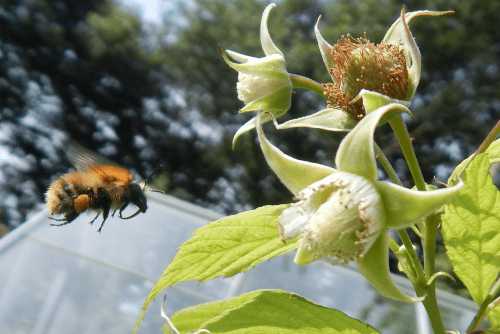 Above, bumble bees like this common carder, have long tongues that fold under the abdomen when flying
Above, bumble bees like this common carder, have long tongues that fold under the abdomen when flying
In short-tongued bees, the tongue is stout and a much shorter straw is formed by just the maxillary palps. Bees with this kind of tongue tend to mop or dab at nectar stores rather than suck them up.
Which bees have long tongues and which bees have short tongues?
Long-tongued bee families:
Megachilidae
Includes for example, mason bees (Osmia), leafcutter bees (Megachile) and resin
bees (Heriades).
Apidae
Includes for example, bumble bees (Bombus); the western honey bee (Apis mellifera)
and Nomad bees (Nomada).
Short-tongued bee familes:
Andrenidae
Includes for example, mining bees (Andrena).
Halictidae
Includes for example, end-banded furrow bees (Halictus) and base-banded furrow
bees (Lassioglossum).
Colletidae
Includes for example, plasterer bees (Colletes) and yellow-face bees (Hylaeus).
Melittidae
Bees of the Melittidae family, including for example, pantaloon bees (Dasypoda), oil-collecting
bees (Macropis) and blunthorn bees (Melitta).
Which bees have the longest tongues?
You'll see from the data below, according to one study, bumble bees (Bombus) had the longest tongue (or glossa) of the all the bees included within the sample.
In the study, the average tongue length for different bumble bee species ranged from 5.27 - 7.68 mm, and the average proboscis length was 7.58 - 10.72 mm.
The bees with the shortest tongue (glossa) in the study were the Hylaeus (Yellow-faced) species, which are very small bees in the bee family 'Colletidae'.
However, it should be noted that there are thousands of different types of bee in the world, and we do not know the tongue length of every existing bee.
How long are the proboscis and the tongue (glossa) in different bees?
Measuring the proboscis and tongues of bees can represent a challenge and most available research tends to focus on the larger bee species, such as the bumble bees, or the intensively studied, such as the western honey bee, Apis mellifera.
However, perhaps one of the most wide ranging was a 2016 study by Cariveau et al1, which measured the proboscis length (including the glossa) of 786 individual bees of 100 species across 5 of the 7 bee families.
Below, I have adapted the data gathered from the study, and grouped the data by bee family and genus. I then provide the mean (average) tongue and proboscis length range for the bee species included within a specific genus.
For example, within the Augochlorini bee genus, the proboscis length ranged from a mean of 1.69mm for the species Augochlorella persimilis, to the mean of 2.75 mm for the species Augochlora (Augochlora) pura pura. The mean length of the glossa for the same was 0.43 mm and 1.14 mm for each of the bee species respectively.
*As stated, the tables below are adapted from Cariveau et al1. Please note that one number is shown where the proboscis of only one bee species was measured for that particular genus.
| Short-Tongued Bees | ||||
|---|---|---|---|---|
| Family | Genus | Mean proboscis length range (mm) | Mean glossa length range (mm) | Mean prementum length range (mm) |
| Andrenidae | Andrena | 1.41 - 2.68 | 0.34 - 0.58 | 1.07 - 2.11 |
| Calliopsis | 3.12 | 1.62 | 1.5 | |
| Colletidae | Colletes | 2.35 - 2.83 | 0.54 - 0.71 | 1.82 - 2.12 |
| Hylaeus | 0.76 - 0.97 | 0.17 - 0.31 | 0.59 - 0.66 | |
| Halictidae | Agapostemon | 3.1 - 3.49 | 1.15 - 1.35 | 1.94 - 2.15 |
| Augochlora | 1.69 - 2.75 | 0.43 - 1.14 | 1.26 -1.62 | |
| Halictus | 2.11 - 2.85 | 0.67 - 1.13 | 1.44 - 1.72 | |
| Lasioglossum | 1.23 - 2.56 | 0.43 - 0.93 | 0.81 - 1.63 | |
| Sphecodes | 1.82 | 0.61 | 1.22 | |
| Long-Tongued Bees | ||||
|---|---|---|---|---|
| Family | Genus | Mean proboscis length (mm) | Mean glossa length (mm) | Mean prementum length (mm) |
| Apidae | Apis | 4.97 | 3.3 | 1.67 |
| Bombus | 7.58 -10.72 | 5.27 -7.68 | 2.31 -3.04 | |
| Ceratina | 2.68 - 3.67 | 1.79 - 2.48 | 0.9 - 1.18 | |
| Habropoda | 9.17 | 6.81 | 2.36 | |
| Melissodes | 4.25 - 6.38 | 2.66 - 3.94 | 1.58 - 2.44 | |
| Nomada | 2.04 - 3.54 | 1.06 - 2.26 | 0.98 - 1.28 | |
| Peponapis | 7.96 | 5.79 | 2.17 | |
| Xylocopa | 7.31 | 4.97 | 2.33 | |
| Megachilidae | Anthidium | 4.62 | 2.61 | 2.01 |
| Coelioxys | 3.71 - 4.09 | 2.64 - 3.03 | 1.05 -1.06 | |
| Heriades | 2.64 - 2.9 | 1.75 - 2.01 | 0.89 | |
| Hoplitis | 2.85 - 4.68 | 1.64 - 3.23 | 1.21 -1.45 | |
| Lithurgus | 9.04 | 7.59 | 1.45 | |
| Megachile | 3.3 - 7.23 | 1.92 - 5.13 | 1.38 - 2.09 | |
| Osmia | 3.67 - 4.96 | 2.42 - 3.22 | 1.26 - 1.74 | |
| Trachusa | 6.48 | 4.54 | 1.94 | |
How bees use their tongues
In addition to feeding on nectar, bees use their tongues to help them line their nests, for communication and understanding their environment, in a sense by ‘tasting’ it.
References
1. Cariveau DP, Nayak GK, Bartomeus I, et al. The Allometry of Bee Proboscis Length and Its Uses in Ecology [published correction appears in PLoS One. 2018 Nov 19;13(11):e0207900]. PLoS One. 2016;11(3):e0151482. Published 2016 Mar 17. doi:10.1371/journal.pone.0151482
Also see: Wilson & Messinger Carril in The Bees In Your Backyard
